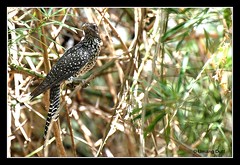The Asian Koel (Eudynamys scolopacea), formerly also Common Koel, is a member of the cuckoo order of birds, the Cuculiformes, which also includes such birds as the roadrunners, the anis, and couas. It is found from southern Asia, China, and into Australia. The subspecies found in the Philippines is sometimes known as the Philippine Koel. Like many cuckoos, it lays its eggs in other birds' nests.
The word koel also means "nightingale" in India because of the Indian Koel's melodious call. It is also colloquially known as the Rainbird or Stormbird in eastern Australia, as its call is supposed to foreshadow rain.
The Asian Koel is a large, long-tailed, cuckoo at 45 cm. The male is bluish-black, with a pale green bill, rich red eyes, and grey legs and feet. The female is brownish above and whitish below, but is heavily striped and spotted brown on the underparts and white on the upperparts. She has an olive or green beak and red eyes.
Koels are very vocal, with a number of different calls.
The Asian Koel is a bird of light woodland and cultivation. It is a mainly resident breeder in tropical southern Asia from India and Sri Lanka to south China and Australasia. Birds at the fringes of the range, such as much of Eastern Australia, and on high ground are summer visitors, migrating to warmer areas in winter. They have great potential in colonizing new areas. They first arrived in Singapore in the 1980s and became very common birds
It is a brood parasite, and lays its single egg in the nests of a variety of birds, including the Jungle Crow, House Crow and various species of honeyeaters. In Sri Lanka it has been noted to parasitize only the Jungle Crow until the 1880 and only later shifted to the House Crow.May also parasitize Black-headed Orioles. The young Koel does not always evict its host's chicks, and initially calls like a crow. The adult koels however may not be leaving their offspring alone entirely:
The Indian koel (E. honorata) is the rain - bird of India. The bird is parasitic on crows, and it would appear from the notes of naturalists in India that the koels must look after their offspring to a certain extent, for they have been seen feeding their own young ones after they have left the nest.
The Asian Koel is omnivorous, consuming a variety of insects, caterpillars, eggs and small vertebrates. Adults predominanty feed on fruit. It has occasionally been known to take eggs of small birds.



No comments:
Post a Comment